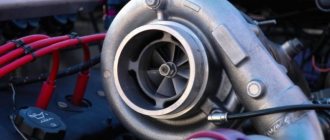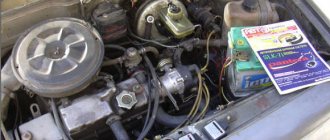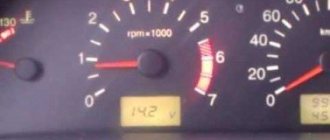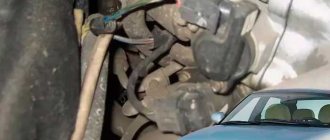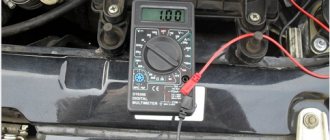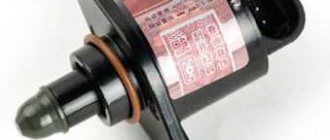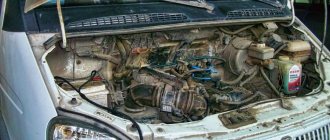If the active use of the car continues for more than 3 years, the owner of the Lada Granta will not be able to avoid the problem of floating speed. But in order to find out the true cause of what is happening on your own, you need to have at least basic knowledge about the design of your car.
When starting the engine, you can observe the following picture: as it warms up, instead of a gradual decline, the speed decreases sharply, and then suddenly begins to change abruptly. In 60% of such cases, the reason is the occurrence of floating revolutions.
In addition, the phenomenon often disappears immediately after the engine starts working. At the same time, visible manifestations disappear and everything returns to normal. But the situation will repeat itself in the future, and more than once.
Over time, the problem will get worse, so don’t put it off for too long. As a result, you will have to spend a lot on expensive repairs.
So why is this happening
Root causes of problems
The most common situations in which floating speeds occur:
- Cars with a built-in electronic fuel injection system suffer from such problems much more often than others. And this happens due to the constant suction of excess air, the volume of which still increases, which leads to the formation of a malfunction. The sensor responsible for gasoline injection simultaneously calculates the volume of air entering the cylinders. Based on these and some other indicators of the sensors, the electronic unit opens the electromagnetic injection valves for some time. It follows from this that when there is an excessive amount of air in them, the sensor, which is responsible for the position of the throttle valve, shows the driver that the task assigned to the system is impossible - the check light is on. During this, the temperature sensor indicates that the engine is exiting the warm-up mode. This indicates that it needs less fuel. Just at such a moment, floating speed appears in the car at idle, because the electronic unit does not understand what to do with the accumulated excess air in the system.
- This reason also partially relates to air suction and occurs mainly on 16-valve engines. The main place where air leaks still occur is the gluing contour of the receiver elements. Even minor damage to this area will lead to unstable operation of the motor.
- Constant jamming also easily becomes a reason for the occurrence of floating speed. It occurs in the crankcase ventilation valve. Therefore, if the reason is precisely this phenomenon, the systematic operation of the automatic power regulation sensor is disrupted. As a result, the same sensor signals instability of the engine. In a faulty state, the speed ranges from 1,300 to 900 per minute.
- In models with a carburetor engine, floating speed occurs due to a violation of the control of the servomotor. To correct this problem, simply unscrew the adjustment bolts in the area of the servomotor where the sensor points to the loose drive.
- Low pressure in the fuel system causes the same problems.
- Breakdowns in the ignition system are sometimes also classified as causes of floating speed. The problem is primarily related to high-voltage wires and spark plugs. But only with a visual inspection will it be possible to understand whether they are really the problem.
- A breakdown of the IAC (idle air regulator) causes floating speeds, because it is responsible for their initial stability. The element is inexpensive and can be replaced, so there may not be any significant problems with this.
- The electronic gas pedal has a lot of disadvantages, especially if tuning the car is only in the process, but the car is actively used. Floating speed is a fairly common occurrence in such a situation.
The speed can fluctuate not only when the engine is cold, but also when the engine is hot. It all depends on the cause of this phenomenon.
So what to do if floating speeds appear with enviable frequency and significantly interfere with the quiet use of the vehicle?
"Let's light a cigarette"
This forced start method is very common in the driver's environment. The idea is to temporarily power the starter from the on-board network (battery) of another car.
For successful “lighting”, we acquire cables with the largest cross-section possible. Cars should be placed in friendly positions - with their hoods facing each other. We connect the positive terminals of the batteries of both cars using one wire. We use another cable to connect the negative terminal of someone else’s battery with the ground of the “native” LADA Granta car.
If the startup attempt is unsuccessful, and the car still does not start, we change the circuit. Now we connect the negative terminals of both batteries directly. Be careful to avoid unauthorized short circuits. Having achieved a successful start, do not rush to remove the cables; let the motor run for a few minutes. Remember the disconnection order: remove the negative wire first, and then the positive wire. Do not activate electrical appliances at this time in order to protect them from damage due to a power surge.
Independent search for the cause
What to pay attention to:
- Check the MAF (mass air flow sensor).
- Examine the IAC.
- Examine the wiring of the DS (speed sensor).
- DPKV (crankshaft position sensor) is the next object of inspection. But the reason, most likely, is not in it specifically, but in its chip or wiring.
- The TPS (throttle position sensor), an element of the throttle assembly, must also undergo a thorough inspection in such a situation. Perhaps a simple cleaning is needed.
- Check high voltage wires and spark plugs.
Once the cause is identified, the problem must be corrected. Your actions in this case depend entirely on what exactly went wrong.
Why does the Lada Granta engine not run smoothly and unstably?
The Lada Granta comes with five main types of engines. Despite the differences in the number of valves and power, they have common problems associated with their own breakdowns. Today we will look at the main reasons why an engine does not work properly.
| TOP 15 most useful products for Lada Granta - OUR EXPERIENCE! |
- 1 Unstable engine operation 1.1 Air supply problems
- 1.2 Spark plugs
- 2.1 Low pressure in the fuel system
- 3.1 Crankshaft pulley
The main reasons for engine stalling at idle
Before we begin to describe the main reasons why the engine stalls at idle, it is worth saying a few words about how this happens. You get into the car and start the engine, which functions as usual. But as soon as you take your foot off the gas pedal, a drop in revolutions is observed, although the idle speed sensor shows the nominal speed.
It should be noted that when you start the engine again, the problem may not appear, and you can easily hit the road, but after a while the engine will stall again. That is why, after discovering the first malfunctions, you should immediately begin troubleshooting.
Almost every car owner has experienced engine stalling.
However, first of all, it is worth determining what exactly may be causing the incorrect operation of the power plant. As a rule, car owners and auto mechanics agree on the following main reasons why the engine may stall at idle:
- malfunction of the idle speed sensor or its complete failure;
- accumulation of dirt in the throttle valve;
- failure of the throttle position sensor;
- contamination of the carburetor or injector (depending on the type of car).
Of course, in some cases the problem may be more trivial: a misaligned battery terminal, an empty fuel tank, the use of low-quality fuel, etc. But we will not focus on them, since even an amateur car owner can solve these problems.
The causes of the malfunction in each individual case may differ radically, so you must be prepared to use various measures to eliminate them. As practice shows, experienced car owners are able to cope with the problem on their own, while beginners are better off immediately seeking the help of specialists.
Experts note that the reasons for stopping the engine when cold and hot are in most cases no different and can be caused by the following malfunctions:
- vacuum leak;
- failure of the distributor cap, rotor, ignition wires or spark plugs;
- incorrectly set ignition timing;
- incorrect operation of the vehicle's ECU (electronic control unit) system, which can only be identified by using a special diagnostic device;
- malfunction of the exhaust gas recirculation valve;
- the presence of mechanical damage to the engine, as well as excessive wear of its elements;
- contamination of fuel injectors;
- malfunction of the idle air control (this problem often appears on Kalina cars).
The reason why the engine stops when cold can be a vacuum leak, dirty fuel injectors, etc.
In most cases, there is no difference whether a gasoline or diesel power unit is installed in your car - the reasons for the engine stopping will be identical. In this case, it is recommended to inspect and clean the throttle valves, and also check the functionality of the idle speed and throttle position sensors.
Moreover, it does not matter whether the engine stalls periodically or regularly - the very presence of the problem indicates a malfunction that must be eliminated as soon as possible.
Unstable engine operation
If the engine runs unstably and stalls when idling, then there are reasons for this. It is quite possible that we are talking about insufficient pressure in the ramp. We also talk about the difficulties in the functioning of the electronic gas pedal.
In the first case, it is worth checking the pressure regulator. Just keep in mind that in new Lada Granta models this regulator may be located in conjunction with the fuel pump. As for the second situation, the check should concern the electronic part of the car, including the power unit adjustment system.
Air supply problems
The problem may also be that there is an air leak in the system. It may be located on the crankcase ventilation hose that connects the inlet pipe to the brake booster. You should carry out additional tightening of the fastening clamps. And, if the need arises, the hoses must be replaced with new ones.
If the problem concerns violation of valve clearances, then the solution requires contacting a service station.
If you own a Granta with an 8-valve engine, it is worth adjusting the timing valves every twenty thousand kilometers.
Or it could be different. If the air filter is clogged, it will be more difficult for air to get through and an overly rich mixture will flow into the injectors. In this case, diagnostics and replacement of the air filter is necessary.
Spark plug
The problem could be the spark plugs.
And, of course, the reason may relate to a malfunction of the ignition system. We are talking about the source of the problem in the form of spark plugs or individual coils. If you have localized the source of the breakdown, then the faulty part must be replaced. On 16-valve engines, AU17D spark plugs are installed from the factory.
More details in the materials:
An indirect factor that may indicate problems with the spark plugs is increased fuel consumption. However, increased consumption may also appear for a number of other reasons; for more details, see the material: reducing the fuel consumption of a Lada Granta car.
And now it won't start
Despite futile efforts, the car still does not respond to activation of the ignition key and does not start. We check the air path filter, since it is very likely to be severely clogged. We try to start with the element removed. If everything works out, we definitely change the consumables. Movement without this element is strictly contraindicated, since the cylinders will instantly become clogged with dust and small abrasive particles. And here it’s not far from damaging the mirrors on the sleeves.
Another common reason when the starter does not turn can be a burnt-out safety element. It's a shame that such a cheap thing can upset the owner. Therefore, stock up on a set of fuses and keep it in your car.
When the engine on a LADA Granta has been running with short-term overheating, it may also subsequently fail to start. To prevent this, it is necessary to periodically “look” into the cooling system and monitor the sensor, pump, and level in the expansion tank, because no one has yet canceled the natural “leakage” of the liquid. Avoid air pockets. Also, pay special attention to the tightness of the circuit, since loosening of clamps on hoses and pipes is a very common occurrence. A fluid leak, especially on the road, will make it impossible to move normally.
Starting the engine is directly related to the functionality of the starter. This unit is a conventional electric motor, which can be tested by connecting to a battery. When the motor does not respond to attempts to start, it is possible that the starter has “visited” problems, especially when the starter does not turn, starting with oxidation of the contacts (including ground) and ending with a malfunction of the solenoid relay. Having determined that the starter is broken, we recommend that you seek qualified assistance in terms of replacement or repair measures, also in the case when the starter turns but does not engage.
A common symptom is the crankshaft sensor "sticking out". This component (DPKV) is designed to monitor and adjust engine speed and then provide this information to the control unit. If the sensor allows itself to break, the car will no longer start, as everyone will be reminded of by the annoying “check” symbol on the dashboard. Sometimes it happens that the sensor is working properly, but dirt stuck to its connector does not allow the correct impulses to be transmitted to the “brain”. Here the launch of the Lada Grant is also expected to fail.
The problem can be resolved with normal cleaning. When this fails, involve specialists to diagnose and replace. You can independently check the gap located between the DPKV winding and the core. The value of this distance should not exceed 1 mm, since its violation will make reading the magnetic pulse impossible.
Inability to gain power
Situations are also possible when the engine makes “heavy” sounds, which is accompanied by the inability to gain full power. And there are reasons for this.
If you purchased Granta new, then the problem may be its newness.
Until a break-in period of 6-7 thousand kilometers is completed, maximum power cannot be gained. Moreover, it is not recommended to increase the crankshaft speed above the 3 thousand mark for the first 2000 thousand kilometers.
Low pressure in the fuel system
If at high speeds it seems to you that the engine:
- does not develop enough power,
- It's like he's hitting a wall
- or when accelerating, “they throw extra weight into tow”
this indicates insufficient pressure in the fuel system. This could be due to a clogged fuel filter. In this case, diagnose and replace the fuel filter.
Bad fuel (gasoline)
The loss of power may be due to low quality fuel, in other words, when you were filled with “badyagu” under the guise of 92 or 95 gasoline. Often, gas stations dilute gasoline with water, or use special “Chinese” cheap additives to increase the octane number of low-grade fuel. In the worst case scenario, you will have to drain all the gasoline from the tank and fill it with new one.
Electronic gas pedal glitches
As in the previous case, the problem may relate to a malfunction of the electronic gas pedal . In addition, there is a chance that the pressure in the ramp is not high enough. The solution to these two problems can be found in the previous section.
The engine will not be able to gain power because the valves are clogged or the spark plugs do not operate stably enough, as a result of which some strokes “skip”.
Insufficient compression
In addition, do not forget about the possibility of low compression in the cylinders, which is less than 1.0 MPa. To find out the reasons for this phenomenon, it is necessary to disassemble the motor. This will make it clear whether the cylinder head gaskets or pistons have burned out, or whether the piston rings have broken or stuck. Among other things, the cause of such compression may be poor adjustment of the timing valves. If the engine has already covered a sufficient mileage, then we are talking about natural wear and tear on the engine components.
On an 8-valve Lada Granta engine, it is necessary to measure compression only after adjusting the valves!
The compression on the Lada Granta should be at least 12-13 atmospheres. If it is more, about 15, then most likely it is necessary to replace the oil scraper rings. If the compression is less, the engine is worn out, it needs to be repaired, it will not develop sufficient traction!
Compression gauge - it is used to measure the compression in the engine
Difference between carburetor and injection filters
After a mileage of 10 thousand kilometers, it is necessary to change the air filter. It is located in a plastic or metal case (on injection and carburetor engines, respectively). If this element looks like the one in the photo below, it should be replaced.
But not only the air is purified in the system. Pay attention to fuel filters too. On diesel engines they are changed every 15 thousand kilometers. As for cars with gasoline engines, they are serviced once every 50 thousand. The throughput of these elements is 10 microns. If low-quality gasoline or diesel was used, the insides of the filter quickly become clogged. There is porous paper inside.
If there is a large amount of dirt, the element is no longer able to clean the fuel. As a result, the car does not hold idle speed and stalls. Even the fact that the pump operates under high pressure does not help. If the filter is heavily clogged, it must be changed immediately. Signs of replacement are also power losses and dips in dynamics.
conclusions
As a rule, improper engine operation is observed for several main reasons. These include the natural deterioration of individual parts, failure to break in the engine, a problem with the fuel line or with the electrical system. In any case, it is necessary to carry out a complete diagnosis, which would allow the problem to be localized and eliminated. If possible, this should be done at a certified service station.
If you do the work yourself, you will need to acquire an electronic error reading system that connects to a computer.
Pumps
If the car stalls at idle, the reason may lie in low pump pressure. On injection engines it is submersible and is located in the fuel tank itself. On carburetor engines, this element is located separately from the tank and is of the mechanical type. This pump is driven by a handle.
If the car does not start at all, it is worth checking the power to the element. Look at the fuses and relays. If on an injection engine the pump does not hum when you turn the ignition key, it means there is no power going to it. On passenger cars it is located in the rear of the passenger compartment, on the right (under the passenger sofa). If it is a diesel power unit, it is worth checking the high pressure fuel pump.
The cause of a stalled engine is the spark plugs
In 50% of cases, the problem is due to the fact that the spark plugs simply do not produce a spark. This failure occurs as a result of 3 reasons:
- contacts become clogged;
- plaque forms along the entire contour of the candle;
- malfunction when supplying voltage to the spark plug.
However, the most popular is still black carbon deposits on the spark plugs, which prevents the spark from appearing or causes it to work periodically.
Tip: if the spark plug set malfunctions, you will hear a “triple” sound that is uncharacteristic of the engine. In this case, the car will jerk strongly while moving. As a result, the engine will either stall on its own, or you will need to turn it off and turn the ignition on again.
If you see dirt on the surface of the contacts, this indicates the need to replace a low-quality type of fuel or check the serviceability of the oil supply systems. It is the oil supply adjustment sensors that can splash the spark plugs with it if there is a problem. Also, oil that appears on a set of spark plugs may indicate serious damage to components in the engine cylinders. Be sure to check the engine at a car service center. Otherwise, further operation may lead to expensive replacement of jet rods and even the entire set of pistons.
If you systematically use low-quality gasoline samples, you may find a red-brown coating on the contour of the spark plug. In this case, cleaning will not help - it is better to immediately replace the entire set after a new refill. If you find that the car periodically turns off at full speed, but starts easily even with clean spark plugs, then the problem lies in the electrical wiring.
Catalytic converters
With the increase in environmental standards, so-called particulate filters began to be installed on diesel cars, and catalysts on gasoline cars. They are designed for a certain service life (about 150 thousand kilometers). Over time, the core becomes clogged. The device cannot produce normal release and purification of exhaust gases.
The way out of this situation is to replace the catalyst with a flame arrester and reflash the electronic unit. But at the same time, the emission standards of your car will drop to Euro-1 values. In the countries of the European Union, the operation of such vehicles is prohibited. But if you drive mainly in the CIS, this is the most optimal solution to the problem. After all, the cost of a new catalyst and particulate filter starts from 40 thousand rubles.
The cause of a stalled engine is a power supply failure
In this type of problem, 3 reasons may be involved:
- Poor contact with the terminals of the new battery;
- Detection of poor contact or breakdown along the entire length of high-voltage wires;
- The appearance of malfunctions in the generator or ignition coil system of the car.
If the problem lies in damp high-voltage wires, then it is best to replace them completely along with the battery contacts. If the terminals make poor contact, you need to carefully clean them with sandpaper and try to reconnect them. If the generator is found to be inoperable, the problem usually boils down to problems in the following parts:
- Broken timing belt;
- There is a malfunction inside the housing of the unit itself.
A problem with the generator is easily detected when the corresponding indicator on the dashboard turns on. In addition, if there is insufficient energy supply, the backlight of the on-board panel will gradually fade, and a set of other diagnostic sensors will show incorrect values.
Advice: if when you press the gas the car jerks, then stalls and cannot start, then the problem is related to the failure of the ignition coils. It is best to replace these parts in a car service using special equipment.
From the list of reasons that are directly related to the car engine, you need to move on to problems that arise in the fuel and air supply systems, as well as malfunctions of components responsible for exhaust gas removal.
Difference between carburetor and injection filters
The reasons for silencing of carburetor and injection engines are somewhat different. So, for carburetor engines, the most common causes are:
- Failure of the carburetor itself due to debris. To fix the problem, you just need to rinse and clean the carburetor.
- A clogged fuel filter, as well as a clogged fuel pump filter mesh, which also need to be cleaned of spent fuel and other dirt.
- Failure of hoses and various rubber connectors - you just need to replace them.
- Failure of the solenoid valve can be resolved by replacing it. To identify the problem, you need to turn on the ignition, remove the wire from it, and after a few seconds connect it again, and you should hear a characteristic click. If there is no click and the warning lamp lights up on the instrument panel, the valve is faulty.
- A clogged idle jet can be solved by cleaning it.
- In some cases, the problem may be associated with incorrect operation of the idle speed sensors, the location of the throttle valve, and the crankshaft.
The idle speed control and the idle speed sensor are not the same thing. In some models they can be combined into one non-separable mechanism, in others - separately
For injection engines, the most common reasons for engine stalling and a drop in speed are:
- Malfunction of the idle speed control.
- Insufficient fuel pressure or air leaks - to eliminate the problem, you need to clean the filters and also make sure that the connecting elements are tight.
- Failure of the vehicle's electronic systems, for repair of which it is recommended to contact a specialized service center.
- Problems in the operation of the mass air flow sensor, as well as malfunctions in the ignition system - the main reason is related to the spark plugs.
On older cars with a carburetor intake system, with such symptoms, the automatic throttle fails. This element “sinks” or is poorly adjusted. If the VAZ-2106 stalls at idle, the malfunction may be accompanied by a leak from the vacuum hoses near the base of the carburetor.
It is worth noting that the pressure levels in these intake systems are different. For injection engines it is many times greater. Therefore, when purchasing new fuel filters, you should check with the seller which engine you have. This is especially true for cars on which different types of systems were installed (for example, old and new “tens”).
If you put a filter designed for a carburetor on an injection engine, it simply will not withstand the pressure. All dirt will end up in the pump injectors. They get clogged, so the engine stalls at idle. As for air filters, they are very easy to distinguish. In carburetor engines they have a round shape.
Fuel supply faults
It is quite easy to find out that the car stalls while driving due to the engine being “choked” with the fuel mixture - during a long drive you will find that the signal of the sensor responsible for this function is constantly on.
Here the problem lies in low-quality fuel, which does not quickly “ignite” from the spark of the candles. It can also be caused by gasoline not meeting the requirements for the octane number specified in the vehicle specifications. If there are problems with fuel, the gas pedal will be pressed all the way, and the car will not begin to gain speed. In addition, the car will periodically stall when the clutch is engaged.
Another symptom indicating problems with fuel is the appearance of problems with the car after refueling. The problem is characterized by a rapid drop in engine power at full speed, as well as when constantly changing gears. The way out of the situation is to completely drain the bad fuel mixture, wash the engine and all the fuel system pipes.
Also, the car will constantly stall if there is an interruption in the supply of the fuel mixture. This may be due to contamination in the following system components:
- Dirt in the fuel filter;
- Problems with injector nozzles;
- Dirty throttle valves;
- Fuel pump power failure.
The main symptom of a malfunction of these parts is that there will be a gradual drop in the power of the car’s engine, after which the car will stall even after sharply pressing the gas pedal. If you do not release the clutch carefully when changing gears, this will also cause the engine to stall.
The contamination of the fuel filter and fuel pump can be judged by the unstable operation of the machine even during idling and during rapid braking (when the supply of the fuel mixture decreases). And if the performance of fuel filters can be easily established during an external inspection and eliminated by replacing them, then to detect other causes, you need a full-fledged computer diagnostics, which can only be carried out in a car service center.
Another reason for a stalled car associated with the operation of the fuel pump is boiling gasoline in the fuel pump. This happens mainly in hot weather when the car is moving slowly or standing on the highway in traffic jams. The car will start to stall while driving, but when you turn on the idle speed and press the clutch, it will start again.
If boiling occurs, it is better to stand in a traffic jam with the engine turned off and gradually cool the car. After 5-10 minutes, the car's operation will be stable again.
Advice: if you recently did a wheel alignment with your own hands on a VAZ-2107, then to cool the car, proceed as follows - throw a piece of cloth made of dense material over the fuel pump body, which you first moisten with cold water.
Diagnostic sequence
No specialist can give any precise recommendations on the diagnostic sequence, but if the problem of a suddenly stalling engine appears periodically, you can wait a little and try to determine under what circumstances it occurs. It would also be a good idea to visit specialized forums dedicated to the problems of a particular make and model of car.
To carry out the most accurate diagnostics, it is recommended to connect the car to a special diagnostic device, which can be found at any specialized service station.
What to do if the car stalls while driving? Little trick on video
And remember that timely maintenance and diagnostics allow you to identify and eliminate possible problems in advance, as well as save your time and money.
Any self-respecting car owner should monitor the health of his car and maintain it in good technical condition. But sometimes there are problems with the startup and operation of the power unit. For example, the engine stalls at idle. What is the reason for this phenomenon, how to deal with it? We will talk about all this in our article today. Before answering the question of why the car stalls at idle, we note that all problems will relate to malfunctions in the supply of the fuel-air mixture.
Malfunctions in the air mixture supply system
Here the problem lies either in a clogged air filter or in the failure of the regulator responsible for idling the car. In this case, your car will stall all the time when you gain speed or when you release the gas when you release the accelerator.
To solve the problem, remove and inspect the air filter. If there is serious contamination or chips, replace it. To diagnose and replace the idle speed regulator, you will need the help of qualified car service employees.
Details about the intake system
Since the engine needs not only gasoline, but also oxygen to operate, problems with speed concern the intake air manifold. Such troubles occur due to air leaks in the place that comes after the filter. As a result, the air flow meter sensor is not able to control the process, and the car stalls at idle.
The injector is often equipped with a mass air flow sensor. You shouldn't ignore it. Often this sensor becomes dirty after 100-150 thousand kilometers. It cannot be repaired - only replaced. This part is inexpensive, but it is precisely because of it that in most cases the idle speed fluctuates. The engine also stalls due to the fuel injectors.
Car exhaust system problem
The engine may also stall if the tubes responsible for removing gases are malfunctioning. At full speed, the car will quickly begin to “choke”, and pressing the gas pedal completely stops the engine. Malfunctions in the operation of the exhaust pipe system in 90% of cases are caused by contamination and clogging of the muffler. However, the catalyst may also fail.
In the first case, carefully clean the muffler and remove foreign objects from there. If there are problems with the catalyst, conduct a complete diagnosis of the exhaust system and replace this element.
What to do if cars with automatic transmission stall?
If your vehicle has an automatic transmission, then the problem should be found in the electrical supply. If you abruptly switch from one gear to another, or while switching gears while braking, the settings may be distorted, and the on-board computer will receive a signal to turn off the engine.
Also, models with automatic transmission may stall due to malfunctions of the hydrodynamic transformers of the gearbox. This problem mainly manifests itself during acceleration and requires urgent intervention from car service specialists.
